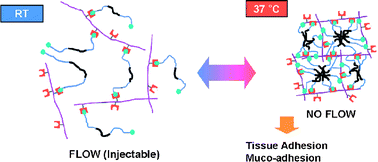Thermo-sensitive, injectable, and tissue adhesive sol–gel transition hyaluronic acid/pluronic composite hydrogels prepared from bio-inspired catechol-thiol reaction
Abstract

* Corresponding authors
a
Department of Biological Sciences and Graduate School of Nanoscience and Technology, Korea Advanced Institute of Science and Technology, Daejeon, 305-701, Republic of Korea
E-mail:
tgpark@kaist.ac.kr
Fax: +82-42-350-2610
Tel: +82-42-350-2621
b Research Institute of Advanced Materials (RIAM), Department of Materials Science and Engineering, Seoul National University, Seoul, 151-744, Republic of Korea
c Department of Chemistry, Korea Advanced Institute of Science and Technology, Daejeon, 305-701, Republic of Korea
d Department of Biomedical Engineering, Northwestern Univeresity, Evanston, Illinois, 60208, USA

 Please wait while we load your content...
Something went wrong. Try again?
Please wait while we load your content...
Something went wrong. Try again?
Y. Lee, H. J. Chung, S. Yeo, C. Ahn, H. Lee, P. B. Messersmith and T. G. Park, Soft Matter, 2010, 6, 977 DOI: 10.1039/B919944F
To request permission to reproduce material from this article, please go to the Copyright Clearance Center request page.
If you are an author contributing to an RSC publication, you do not need to request permission provided correct acknowledgement is given.
If you are the author of this article, you do not need to request permission to reproduce figures and diagrams provided correct acknowledgement is given. If you want to reproduce the whole article in a third-party publication (excluding your thesis/dissertation for which permission is not required) please go to the Copyright Clearance Center request page.
Read more about how to correctly acknowledge RSC content.
 Fetching data from CrossRef.
Fetching data from CrossRef.
This may take some time to load.
Loading related content
